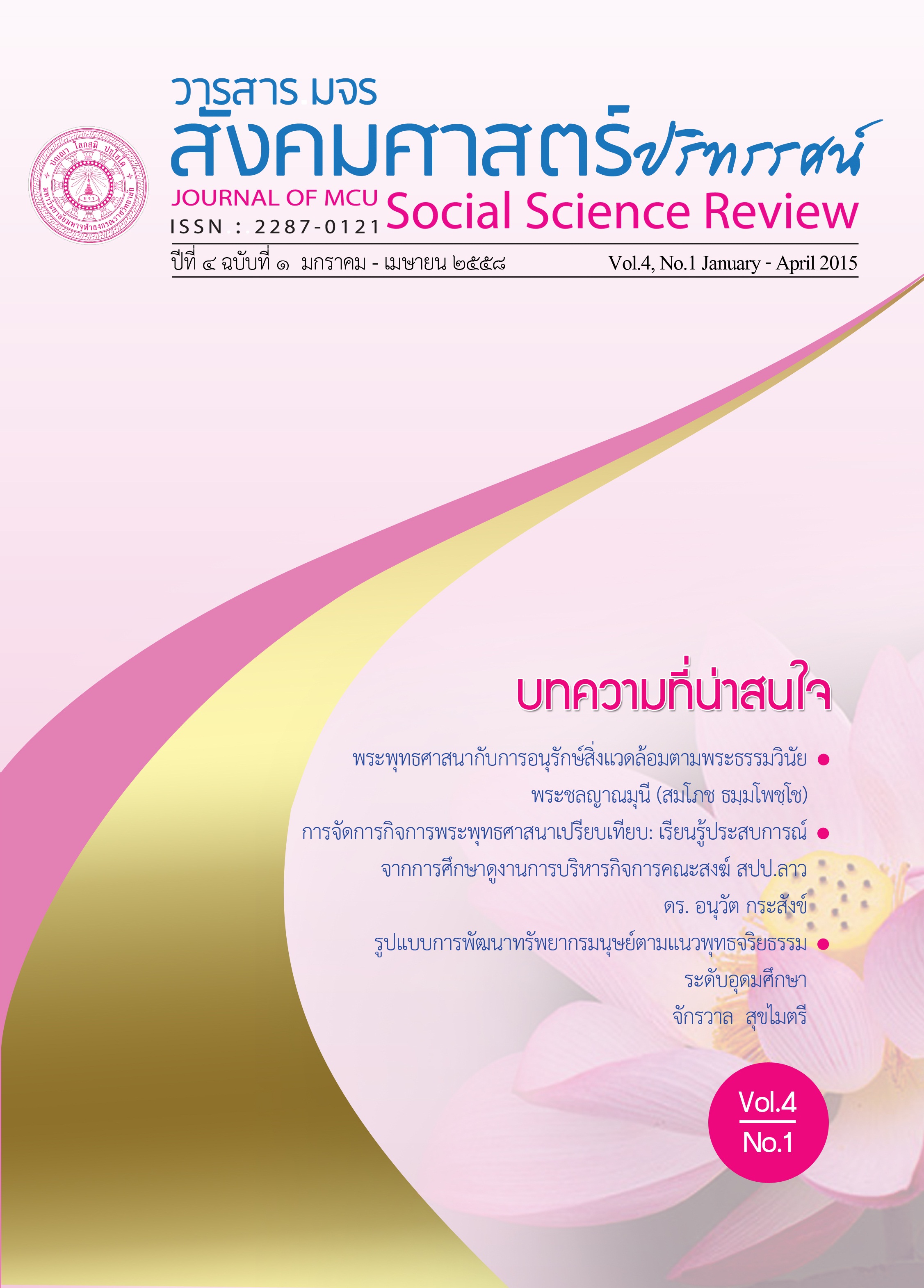องค์กรแห่งความสุขกับคุณภาพชีวิต
คำสำคัญ:
องค์กรแห่งความสุข, คุณภาพชีวิตบทคัดย่อ
องค์กรแห่งความสุขเป็นกระบวนการพัฒนาคนในองค์กร อย่างมีเป้าหมายและยุทธศาสตร์ ให้สอดคล้องกับวิสัยทัศน์ของ องค์กร เพื่อให้องค์กรมีความพร้อมต่อการเปลี่ยนแปลง มีคุณภาพ ชีวิตที่ดี ซึ่ง จะนําไปสู่การพัฒนาเติบโตอย่างต่อเนื่องขององค์กร ซึ่งเป็นการจัดการองค์กรโดยเน้น การจัดการ “คน” เป็นหลักแนวคิดของการจัดสมดุลชีวิตของมนุษย์ผ่านความสุขในโลกสามใบที่ทับ ซ้อนกันอยู่ โลกส่วนตัวของมนุษย์ โลกครอบครัวของมนุษย์ และโลกสังคมของมนุษย์ เพื่อที่จะมอง ความสุขของมนุษย์ทั่วไปว่ามีองค์ประกอบอะไรบ้างและจะจัดการได้อย่างไร โดยขีดวงรอบที่ตัวคน แล้วก็วงรอบของครอบครัวแล้วก็วงรอบของสังคม ซึ่งในส่วนของสังคมเราแบ่งเป็นส่วนสังคมภายใน องค์กรกับนอกองค์กร มองความสุขเป็นสามส่วนคือ ความสุขของตัวเราเอง ความสุขของครอบครัว ความสุขขององค์กรและสังคมเป็นแนวทางหนึ่งในการบริหารจัดการชีวิตให้มีความสุขอย่างยั่งยืน สร้างทัศนคติบวกต่อมุมมองในการดําเนินชีวิต การอยู่ร่วมกับผู้อื่น การรับผิดชอบต่อสังคม เป็น สมาชิกที่ดีต่อครอบครัว องค์กรและสังคม โดยมีความสุขที่แท้จริงบนพื้นฐานความสุขแปดประการมี สมดุลชีวิต เกิดผลเป็นบุคคลที่มีสุขภาพดีดูแลตนเองไม่เป็นภาระแก่ใคร มีน้ําใจช่วยเหลือผู้อื่น มี คุณธรรม กตัญญ มีการเรียนรู้เป็นมืออาชีพในงานตนเอง รักและดูแลครอบครัว รักและดูแลองค์กร/ สังคม
เอกสารอ้างอิง
(๑) หนังสือ
สํานักงานคณะกรรมการข้าราชการพลเรือน (สํานักงาน ก.พ.), การเสริมสร้างคุณภาพชีวิตและการทํางาน กระแสใหม่ของการบริหารทรัพยากรบุคคล, กรุงเทพมหานคร: บริษัท แอร์ บอร์นพรินต์ จํากัด, ๒๕๕๐.
(๒) วิทยานิพนธ์
กัญญาวีณ์ สุวิทย์วรกุล. อิทธิพลของการรับรู้วัฒนธรรมองค์การคุณภาพชีวิตการทํางานต่อผลการปฏิบัติงานของพยาบาลวิชาชีพโรงพยาบาลของรัฐในกรุงเทพมหานคร. วิทยานิพนธ์ ปริญญามหาบัณฑิตคณะสังคมศาสตร์และมนุษย์ศาสตร์ บัณฑิตวิทยาลัย มหาวิทยาลัยมหิดล, ๒๕๕๐.
๒. ภาษาอังกฤษ
(1) Book
Collins. McCall, S. Quality of life. Social Indicators Research, 1975.
Lyubomirsky,s., King, L.A, &Diener, E. The Benefits of Frequent Positive Affect. Psychologicol Bulletin, 2005.
Kim, M. and Cho, K.H. Quality among Government Employees. Social Indicators Research, 2003.
Maslow, A.H. Motivation and Personality. New York: HarperNew Economics Foundation. 2009.
The Happy Index 2.0. London, United Kingdom, 1954.
Oliver, J.P.J. et al. Quality of Life and Mental Health Service. London: Routledge, 1996.
Royuela, V., López-Tamayo, J. and Suriñach, J. The institutionalV.S. the academic definition of the quality of work Life: whatis the focus of the European Commission? Springer.United Nations. 2009.
Human Development Report 2009. New York, USA: United Nations, 2007.
VentegodtSøren, Joav Merrick and NielsJørgen Andersen. Quality of Life theory l: the IQOL Theory: an Integrative Theoryof the Global Quality of Life Concept. The Scientific World Journal, 3. 2003.
ดาวน์โหลด
เผยแพร่แล้ว
รูปแบบการอ้างอิง
ฉบับ
ประเภทบทความ
สัญญาอนุญาต
ลิขสิทธิ์ (c) 2018 วารสาร มจร สังคมศาสตร์ปริทรรศน์

อนุญาตภายใต้เงื่อนไข Creative Commons Attribution-NonCommercial-NoDerivatives 4.0 International License.
เพื่อให้เป็นไปตามกฎหมายลิขสิทธิ์ ผู้นิพนธ์ทุกท่านต้องลงลายมือชื่อในแบบฟอร์มใบมอบลิขสิทธิ์บทความให้แก่วารสารฯ พร้อมกับบทความต้นฉบับที่ได้แก้ไขครั้งสุดท้าย นอกจากนี้ ผู้นิพนธ์ทุกท่านต้องยืนยันว่าบทความต้นฉบับที่ส่งมาตีพิมพ์นั้น ได้ส่งมาตีพิมพ์เฉพาะในวารสาร มจร สังคมศาสตร์ปริทรรศน์ เพียงแห่งเดียวเท่านั้น หากมีการใช้ภาพหรือตารางหรือเนื้อหาอื่นๆ ของผู้นิพนธ์อื่นที่ปรากฏในสิ่งตีพิมพ์อื่นมาแล้ว ผู้นิพนธ์ต้องขออนุญาตเจ้าของลิขสิทธิ์ก่อน พร้อมทั้งแสดงหนังสือที่ได้รับการยินยอมต่อบรรณาธิการ ก่อนที่บทความจะได้รับการตีพิมพ์ หากไม่เป็นไปตามข้อกำหนดเบื้องต้น ทางวารสารจะถอดบทความของท่านออกโดยไม่มีข้อยกเว้นใดๆ ทั้งสิ้น





